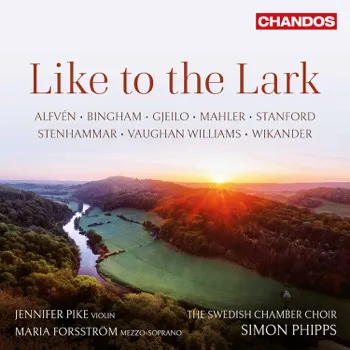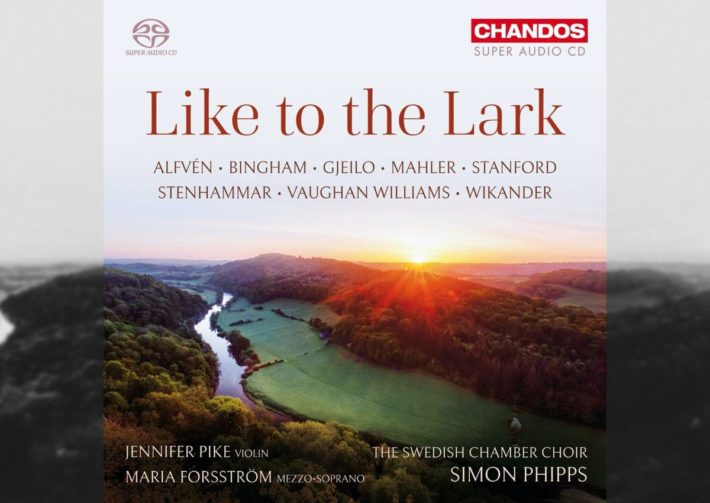Ralph Vaughan Williams’s “The Lark Ascending” is one of the most admired and loved pieces of English music in his homeland, but outside the UK it is less well known. It is most familiar in its 1920 orchestral arrangement, recorded by many violinists, notably twice by the doyenne of British violin music — violinist Tasmin Little, both with Sir Andrew Davis. The color and ambiance of this piece are appreciated more so when compared to the original 1914 version for violin and piano, recorded by violinist Matthew Trusler and pianist Iain Burnside.

In 2018 Paul Drayton made an arrangement for chamber choir and violin, recasting the orchestral parts with inherent sensitivity — vocally. In the center of the piece, Drayton sets text from George Meredith’s poem on which Vaughan Williams’ work is based. Joining the Swedish Chamber Choir and director Simon Phipps in this arrangement is violinist Jennifer Pike, who together produce a very poignant performance. This isn’t Pike’s first recording of the piece, but of her two this is the most innovative, confident and distinctive. The unity between choir and soloist is as remarkable as the tonal palette, with flawless phrasing and intonation throughout.
Preceding “The Lark Ascending” and creating the backdrop to this program’s journey is Vaughan Williams’ “Rest” and “Three Shakespeare Songs”, both for unaccompanied choir. The Swedish Chamber Choir gives worthy performances, capturing an attractive choral sound that the composer would have been familiar with. Phipps interpretations give different insights compared with the Tenebrae Choir, who are experts in this repertoire and released this repertoire under an album named “Music of the Spheres” a few years back. In “Rest”, the Swedish Chamber Choir captures the same mood, but with different hues from Tenebrae’s more yearning version.
In the first of “Three Shakespeare Songs”, “Full Fathom Five” (track 2), the Swedish Chamber Choir creates a more mysteriously atmospheric rendition than Tenebrae, whilst in “The Cloud-Capp’d Towers” (3), their more ethereal bells are heard through the heady autumnal mists rather than Tenebrae’s biting frosty air. This is as equally moody and musical as Tenebrae, but the Swedish Chamber Choir lacks the same clarity of diction. Finally, “Over Hill Over Dale” (4) captures the spirit of English folk music, but again the choir just lacks the pristine pronunciation that elevates Tenebrae’s performance.
After a welcome few seconds of silence following “The Lark Ascending”, we hear Judith Bingham’s “The Drowned Lovers” (track 6), featuring mezzo-soprano Maria Forsström. Her rich voice with clear diction, laden with alto tones reminiscent of Kathleen Ferrier, evokes the tragic tale. Charles Villier Stanford’s choral miniature “The Blue Bird” (7) is performed with a yielding warmth, especially when compared to Short with Tenebrae – aided by Phipp’s slightly broader tempo. Wilhelm Stenhammar’s “Three Choral Songs” (8-10) have a more conservative harmonic language than the preceding pieces, which echo the moods and length of Vaughan Williams’ “Three Shakespeare Songs”.
The final sequence of works by Hugo Alfvén, David Wikander and Gustav Mahler provides the most gentle but sympathetic precursors to the ultimate piece on the album, that of Ola Gjeilo’s “Serenity” — a setting of “O Magnum Mysterium” (for choir and violin/cello). It once again features Pike’s violin playing. Her intoxicating vibrato is used with a huge conviction (a sound reminiscent of Stephen Isserlis’ impressive cello playing in Taverner’s “The Protecting Veil”). The Swedish Chamber Choir shows exceptional control sustaining and shaping their long phrases. Phipp’s pacing is slow, which provides the perfect transcendental conclusion with poise, peace and tranquility.
“Like to the Lark” is more concerned with pieces echoing Vaughan Williams’ sound world rather than music concerned with the bird. This diligently programmed album is characterized by the exquisite tone of the Swedish Chamber Choir, who sing consistently with unity and precision. In the most complex textures, the colors of each voice remain distinctive but blend effortlessly, a credit to the direction of Simon Phipps. The booklet in Chandos’ homestyle has notes, texts and translations. Engineering is excellent, the acoustic of Årstads Kyrka, Heberg, Sweden, enhances without overwhelming or blaring the choral sounds, whilst skilful balancing allows the sopranos to soar to the rafters with comfort. All in all, this album has much to offer as an approachable and engaging journey into choral music.
“Like to the Lark”
Works by Vaughan Williams, Judith Bingham, Charles Villiers Stanford, Wilhelm Stenhammar, Hugo Alfvén, David Wikander, Gustav Mahler, Ola Gjeilo
Maria Forsström – Mezzo
Jennifer Pike – Violin
The Swedish Chamber Choir
Simon Phipps – Conductor
Chandos, Hybrid SACD CHSA 5255




















